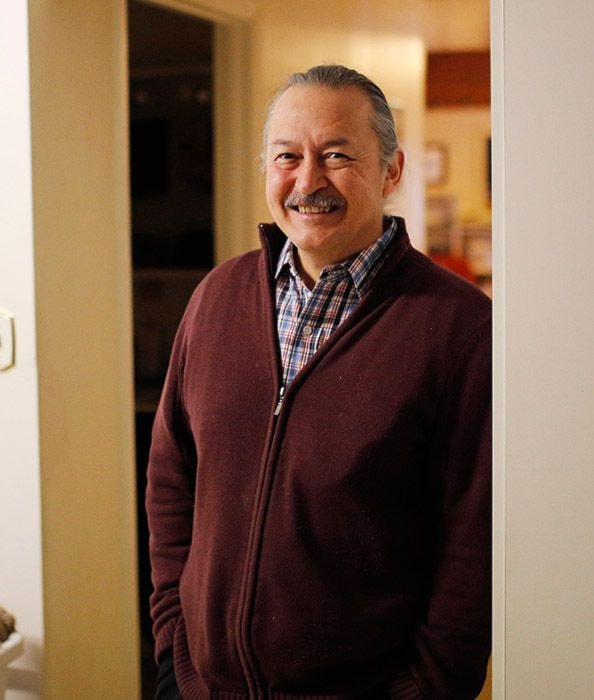You know about totem poles.
You’ve seen the ravens, bears and thunderbirds on drums and button blankets. You’ve seen them depicted in red, black and blue-green, always using those rounded, bulging, oval-rectangular shapes called ovoids.
This is Northwest Coast art, among the most distinctive First Nation art forms. It’s commonly used in the Yukon — the artwork on the exterior of the Kwanlin Dun Cultural Centre in Whitehorse is a good example.
But Ukjese van Kampen says Northwest Coast art isn’t the traditional art form of Yukon First Nations. The Northern Tutchone artist believes it was imported as recently as 30 years ago, in an attempt to revive First Nations culture in the territory.
Van Kampen, a member of the Kwanlin Dun First Nation, will discuss the history of Indigenous art in the Yukon as part of the Long Ago Yukon lecture series at the Yukon Beringia Interpretive Centre in Whitehorse on Saturday, Jan. 14.
He wants people to know that, generations ago, Yukon First Nations created their own, unique art.
“The importance, I think, for Yukon First Nations people is to say, ‘Okay, who are we and what did we do?’” he said. “Right now, I think there’s still a deep sense of feeling that we’re not too sure who we are.”
Van Kampen published a thesis on the history of Yukon First Nations art as part of his doctoral degree in 2012.
He said the earliest evidence of Yukon art dates back thousands of years, and is characterized by repeating geometric shapes, like crosses, dots and cones. He refers to this as the geometric period. He said those repeating patterns have been found on arrow quivers, knives, spoons and other tools, and were used all over the Yukon and into eastern Alaska, northern British Columbia and the western Northwest Territories.
He believes that geometric art form would have stayed largely unchanged until the 1800s, because Indigenous people maintained a similar lifestyle to that of their ancestors thousands of years earlier.
“Your main task would have been out hunting animals. You would have used hide clothing,” he said. “Essentially all that technology would have been the same.”
But in the mid-19th century, all that began to change, van Kampen said. And it wasn’t because of the Gold Rush.
Traditionally, the Athapaskan-speaking people of the southwest Yukon — a language group that includes the Northern and Southern Tutchone, Dene, Kaska and Gwich’in — traded extensively with the coastal Tlingit. As the Tlingit began dealing with European fur traders, European goods began making their way into the Yukon.
“By the 1880s, we were pretty well mostly wearing Western clothing, even though there were no white people in the Yukon,” van Kampen said.
An artistic transformation accompanied that cultural shift, he said. When glass beads showed up in the Yukon, Indigenous people began to use them instead of porcupine quills to decorate clothing.
Gradually, beaded floral designs replaced the traditional geometric shapes. Van Kampen calls this the beaded period.
But the most significant change, he said, happened during the Second World War, when the Alaska Highway was built and it became easier to move around the territory. Until then, van Kampen said, most First Nations people still lived traditional lifestyles and spoke their own languages.
But after the war, it became much easier to send First Nations children to residential school.
“World War II plays a major role in the destruction of the original culture here,” he said. “Now (after the war), there’s no language, no spirituality… no art.”
Van Kampen believes Yukon First Nations adopted Northwest Coast art in recent decades as an attempt to revive Indigenous artistic culture. Northwest Coast art was an obvious choice, he said, because distinctive elements like totem poles survived the cultural destruction that took place elsewhere.
He suspects most First Nations people in the Yukon don’t know that their ancestors produced an entirely different type of artwork.
“There’s really no information available for them to find it, so there’s nobody telling them, ‘Okay, this is what they did.’”
He said little is known about traditional art in the territory, because there was little interest in the region’s Indigenous culture generations ago, and few artifacts were collected.
“The official opinion … is we were the most backward of all people, the most backward of all Native Americans, and there was nothing of interest that we had.”
He said there’s not much incentive to teach traditional Yukon art today, either, because it wouldn’t sell as well as the more recognizable Northwest Coast art.
Van Kampen claims he’s not on a mission to change the way Indigenous art is taught in the Yukon, because he doesn’t believe anything will change. His Long Ago Yukon talk, he said, is just an analysis of the history of Yukon art — nothing more.
“I’ve been going on about this for years. There’s been no changes,” he said. “If I cared, I would be driven bonkers, so I have to not care.”
But at times, it seems, frustration still bubbles to the surface. “There’s a lot of talk in the Yukon about the importance of heritage and culture and it’s mostly talk,” he said. “It’s not going to change.”
Van Kampen’s talk is scheduled for 1 p.m. at the Beringia Centre on Saturday, Jan. 14. His own artwork has been featured in exhibits around the world, including in Germany, the United States and Australia.
Contact Maura Forrest at maura.forrest@yukon-news.com
